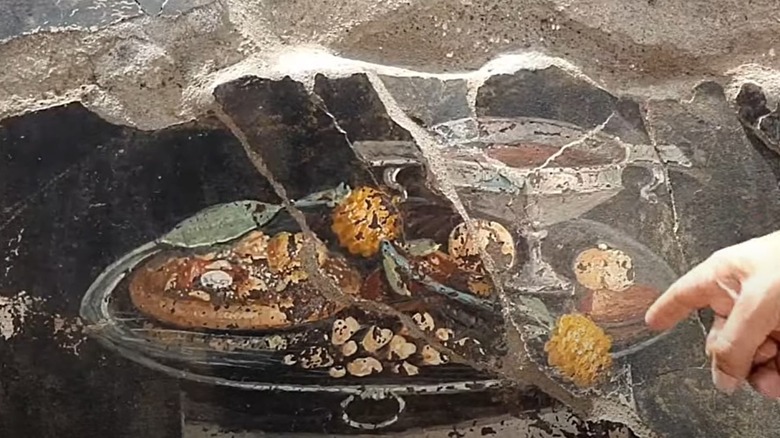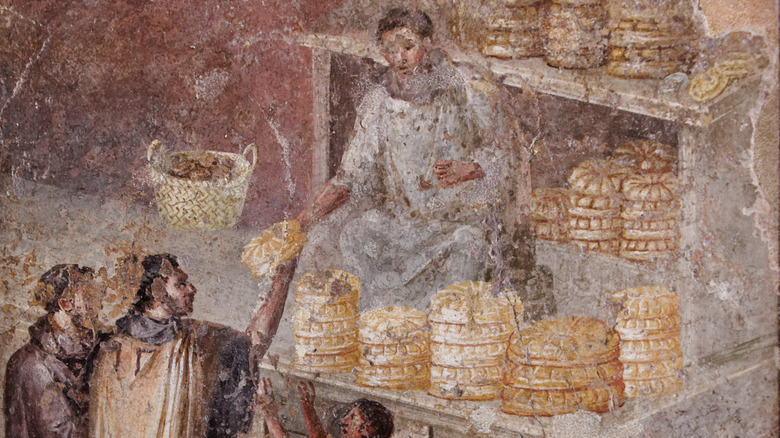The Strange Connection Between Ancient Pompeii And Italy's Signature Dish
In case anyone needs any reminders that humans have never, ever been any different: Have a look at some of the frescos — wall paintings — of the ancient Roman city of Pompeii. Usually, we glimpse history through the eyes of kings, queens, big events, wars, cataclysms, treaties, and the like. Even classroom textbooks in school are often framed in terms of, "Guy X was king over land Y before conquering people Z on such-and-such date."
But what about everyday people? The poor, the immigrants, the stay-at-home moms, the carpenters and bricklayers, the enslaved, and so forth. They weren't writing big, historical tomes about how hard it was to get by. But have no fear, because ancient Pompeii is here. And all it took was the city and its inhabitants getting smothered in ash in 79 B.C.E. The eruption of Mt. Vesuvius took people's lives, but gave them a voice.
Rather than chronicle peasant memoirs on pricey papyrus, though, folks scribbled graffiti in public bathrooms proclaiming messages like, "Gaius Pumidius Diphilus was here," or, "Sanius to Cornelius: Go hang yourself!," per The Atlantic. Pompeiians painted couples in various sexual poses on the walls of brothels. They drew comic book-like scenes from popular stories across the walls of homes. And now? As the BBC reports, we've discovered a Pompeiian fresco of a very familiar-looking, rather modern-looking Italian food: pizza. It's not the exact same dish, but it's definitely in the family.
A fruit-topped flatbread disc
Before you start thinking that folks in ancient Pompeii were chowing down on a Dominoes XL Meat Lover's Plus Pizza or whatever, it's important to note all the differences between the dish we've discovered and its modern descendant. Also: No self-respecting Italian — even those living over 2,000 years ago, we assume — would go within 10 feet of Dominoes. Just saying.
As the BBC points out, the Pompeii-zza in question was more of a flatbread topped with a bunch of savory and sweet items. We've got apricots, peaches, apples, quail eggs, a bit of cheese, and a bay leaf spread over a smallish, circular, thick, baked bread with a pizza-like crust. There might have been some pureed fruit involved, as well as some warm honey poured into the center of it all. So sure, it goes hard on the carbs but is really more of a mealtime fruit spread arranged on an edible plate.
And lo and behold, that's exactly the joke written in the epic Latin poem "The Aeneid" by Virgil: "To break the fateful circles of bread boldly with hands and jaws, not sparing the quartered cakes, Iulus, jokingly, said no more than: 'Ha! Are we eating the tables too?'" "The Aeneid," written several decades after Pompeii was destroyed, also gives us a name for the dish: adoreum (singular), or adorea (plural). Sounds an awful lot like "adore," doesn't it? The word isn't related, but we're pretty sure folks did adore it.
A lowbrow Napolitano street food
Admittedly, it seems like a no-brainer to look at piece of plain bread and say, "Hey, why don't I put some stuff on this?" Bread has been a universal, staple dish across Western societies for thousands of years. This is why the Pompeiian flatbread in question is more of a spiritual ancestor of modern pizza rather than any kind of direct culinary forebearer. In fact, some sites like NPR and Live Science very ardently declare that the painted adoreum is most certainly "not a pizza."
But as it turns out, it's not even correct to call pizza "Italian." That's like calling New Orleans red beans and rice "American," as though the dish comes from the whole country. Pizza comes from a time when Italy was a bunch of different states and pre-dates the formation of the modern Italian nation in 1861. As History explains, pizza originated as a grubby worker's street food in Naples back in the late 1700s. An Eccentric Culinary History explains that Italian immigrants to North and South America from the 1880s through 1910s took the dish with them, where it got popularized. Pizza wasn't even readily available in Italy until the 1960s because it was considered lowbrow.
Nonetheless, as the BBC shows, the specter of future pizzerias abounded in ancient Pompeii. A famous Pompeiian fresco (shown above) depicts a baker surrounded by tables of stacked, round flatbread waiting for customers to buy and pile high with fruit, honey, eggs, and more.
[Featured image by Naples National Archaeological Museum via Wikimedia Commons | Cropped and scaled]


